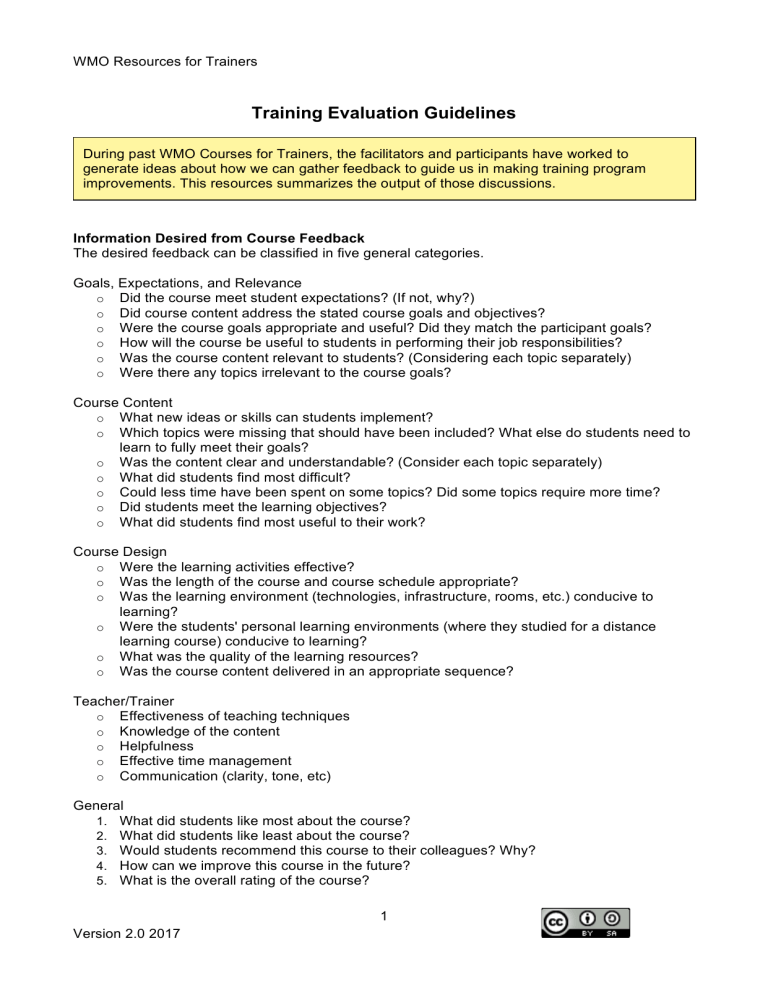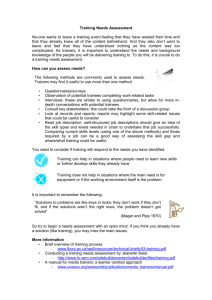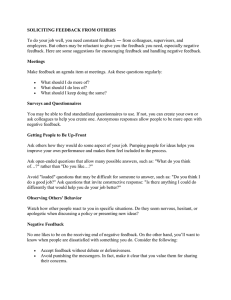
WMO Resources for Trainers Training Evaluation Guidelines During past WMO Courses for Trainers, the facilitators and participants have worked to generate ideas about how we can gather feedback to guide us in making training program improvements. This resources summarizes the output of those discussions. Information Desired from Course Feedback The desired feedback can be classified in five general categories. Goals, Expectations, and Relevance o Did the course meet student expectations? (If not, why?) o Did course content address the stated course goals and objectives? o Were the course goals appropriate and useful? Did they match the participant goals? o How will the course be useful to students in performing their job responsibilities? o Was the course content relevant to students? (Considering each topic separately) o Were there any topics irrelevant to the course goals? Course Content o What new ideas or skills can students implement? o Which topics were missing that should have been included? What else do students need to learn to fully meet their goals? o Was the content clear and understandable? (Consider each topic separately) o What did students find most difficult? o Could less time have been spent on some topics? Did some topics require more time? o Did students meet the learning objectives? o What did students find most useful to their work? Course Design o Were the learning activities effective? o Was the length of the course and course schedule appropriate? o Was the learning environment (technologies, infrastructure, rooms, etc.) conducive to learning? o Were the students' personal learning environments (where they studied for a distance learning course) conducive to learning? o What was the quality of the learning resources? o Was the course content delivered in an appropriate sequence? Teacher/Trainer o Effectiveness of teaching techniques o Knowledge of the content o Helpfulness o Effective time management o Communication (clarity, tone, etc) General 1. What did students like most about the course? 2. What did students like least about the course? 3. Would students recommend this course to their colleagues? Why? 4. How can we improve this course in the future? 5. What is the overall rating of the course? 1 Version 2.0 2017 WMO Resources for Trainers Methods for Gathering Course Feedback Trainers may want to consider a variety of methods to ensure they get a broad spectrum of feedback on what works well and what might improve future offerings of the course. The range of available methods is broad, and the opportunities to gather feedback are many. Feedback Methods • • • • • • • • • • • • • • • • • • • End-of-course Questionnaires Mid-course Questionnaires Discussion about the course with the entire class Discussion with a small group Scheduled meetings with individual students Informal meetings at social events (lunch, dinner, field trips, coffee, etc.) During test reviews and feedback sessions (going over the test to explain how students performed and what wasn't clear) Using homework results as a clue to how the course is going Using classroom discussions to determine how well students are learning Using frequent quizzes, problems, and questions to gauge learning Administering long-term feedback questionnaires to students and/or supervisors in the departments they work after the course (six months to one year afterward) Assign student representatives to bring student concerns to the teachers/trainers Documenting your own observations during the course Using a forum, blog, or wiki to gather feedback on training activities Have students develop a learning portfolio or learning diary during the course Discuss the course with your colleagues, instructors and/or superiors Use an outside observer to gather objective feedback from students Use pre-course feedback to compare with post-course feedback Analyze student tests and the results of your learning assessment methods to judge the effectiveness of the course Who can provide useful course feedback in addition to students? Source of course feedback Student supervisors Work colleagues Students who dropped the course Your project team (facilitators, coinstructors, observers, developers, etc.) Feedback they can provide Changes in work performance after training (typically more effective some months after training), or records of good and bad performance Changes in work performance after training, what knowledge students have shared with their colleagues after the course Those factors that led them to choose to drop out Observations about effectiveness of course interactions; difficult points during the course; ways to improve the planning, development, and implementation processes 2 Version 2.0 2017 WMO Resources for Trainers Guidelines for Writing End-of-course Evaluation Questions The most common and efficient way to gather evaluation on courses is to use a survey evaluation administered to students at the end of a course. The following is a short list of guidelines for creating end of course evaluations. 1. Looking over the list of information desired (provided above), select those of most 2. 3. 4. 5. 6. 7. 8. importance to you. Some will overlap, and so a separate question for each information type probably is not needed. o If you hope to get useful feedback from as many students as possible, your course evaluations should be short, even if you might desire a broad range of information. Consider trying to keep the number close to 10, if possible, and use other methods for additional feedback. Be specific in your wording. o “Did the course meet your learning expectations?” is better than “Was the course a good one for you?” Do not embed two questions in a single item. If you need answers to both, separate them. o Avoid questions like: “Did you achieve the learning objectives and was the course a success for you?” If you consider these redundant, use one only. If you consider them unique, make two questions. Use closed items (those with specific choices) when you want to have respondents use the same frame of reference, and for easier analysis, particularly comparing multiple courses. o Forced answers such as 1 to 5, Strongly Agree, Agree, etc. give a useful numerical average. Even if some participants tend to rate higher or lower than others, the results average out in groups. o Forced answers can remove ambiguity: “Was the length of the course appropriate?” (Too long/just right/too short) are better choices than (yes/no) o Forced answers in questions like the one that follows can make sure people are answering with the same category of things in mind: “Which of the following was MOST important to your learning in the course?” (hands-on exercises, lectures, large-group discussions, periodic quizzes, small-group projects) Also use a sufficient number of open-ended (written response) questions to understand the closed responses better, and to give people a chance to clarify their opinions in their own words. o Open-ended questions (“What was the most useful thing you learned in the course?”) can provide more useful information for course revision than general questions (“This course was relevant to me. Agreement level: 1-2-3-4-5”) o Open ended items can be used to follow up on closed items to provide more information. You may even want to include an option to write an open-ended response for EACH closed one. o Open-ended items take longer to analyze, but can provide the most useful information for knowing how to revise a course. They can also provide convincing evidence on the quality of a course beyond numerical ratings. For some items, consider if it is better to include a No Opinion or Not Applicable option. o Not all students will use all available resources, for example. Consider leaving out a middle option on scaled questions to ensure that you measure how people lean. (In other words, rather than using a 1-5 scale, where 3 is neutral, offer 6 options) o Experts do not agree whether leaving out the middle option is good practice, but if you do leave it out, provide at least a 1-6 scale to better understand the intensity of the opinion. Using only 1-4 may make opinions look stronger than they actually are. Avoid using too many “Agree-Disagree” items. Substitute other choices when possible. o People too easily tend to agree. Substitute other more meaningful scales when possible, such as “Useful-Not useful,” “Too much-Too little,” “Always-Never,” etc. 3 Version 2.0 2017



